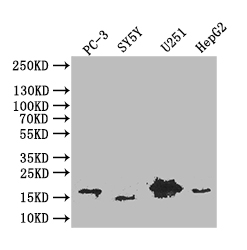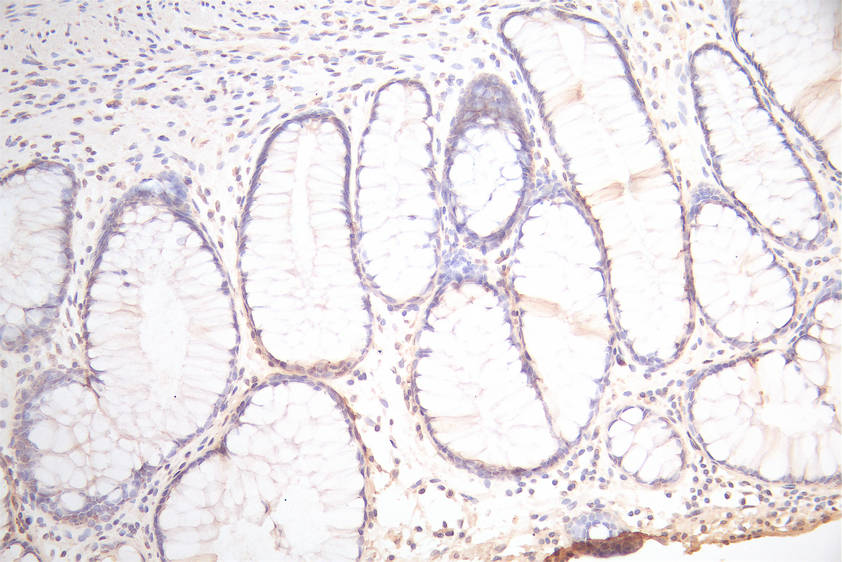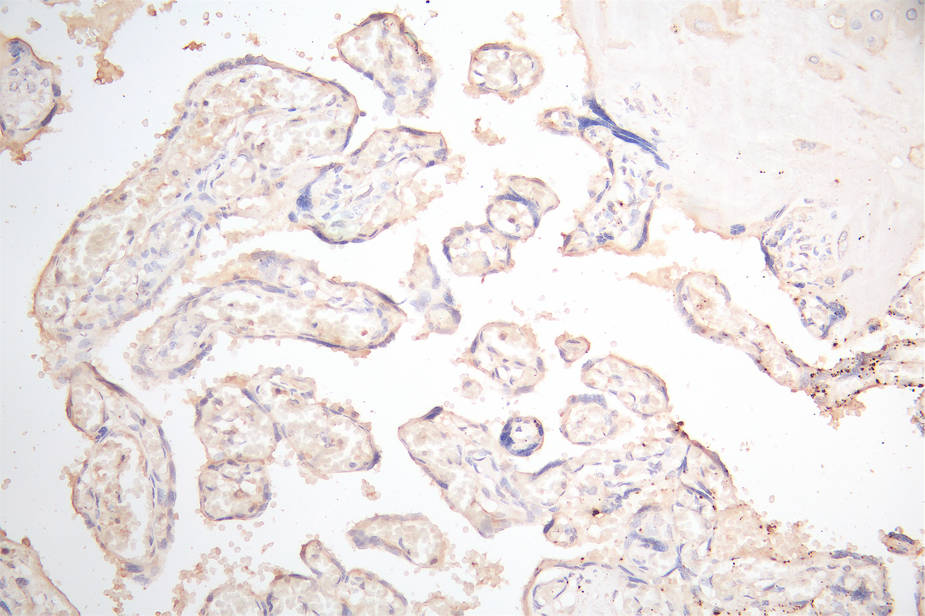PDPN Recombinant Monoclonal Antibody
-
货号:CSB-RA017739MA1HU
-
规格:¥1320
-
图片:
-
Western Blot
Positive WB detected in: PC-3 whole cell lysate, SY5Y whole cell lysate, U251 whole cell lysate, HepG2 whole cell lysate
All lanes: PDPN antibody at 1:1000
Secondary
Goat polyclonal to mouse IgG at 1/50000 dilution
Predicted band size: 17 kDa
Observed band size: 17 kDa -
IHC image of CSB-RA017739MA1HU diluted at 1:300 and staining in paraffin-embedded human colorectal cancer performed on a Leica BondTM system. After dewaxing and hydration, antigen retrieval was mediated by high pressure in a citrate buffer (pH 6.0). Section was blocked with 10% normal goat serum 30min at RT. Then primary antibody (1% BSA) was incubated at 4°C overnight. The primary is detected by a Goat anti-Mouse IgG labeled by HRP and visualized using 0.05% DAB.
-
IHC image of CSB-RA017739MA1HU diluted at 1:300 and staining in paraffin-embedded human placenta tissue performed on a Leica BondTM system. After dewaxing and hydration, antigen retrieval was mediated by high pressure in a citrate buffer (pH 6.0). Section was blocked with 10% normal goat serum 30min at RT. Then primary antibody (1% BSA) was incubated at 4°C overnight. The primary is detected by a Goat anti-Mouse IgG labeled by HRP and visualized using 0.05% DAB.
-
Overlay Peak curve showing 293 cells stained with CSB-RA017739MA1HU (red line) at 1:100. The cells were fixed in 4% formaldehyde (15min) and permeated by 0.2% TritonX-100 for 10min. Then 10% normal goat serum to block non-specific protein-protein interactions followed by the antibody (1ug/1*106cells) for 45min at 4℃. The secondary antibody used was FITC-conjugated Goat Anti-Mouse IgG(H+L) at 1/200 dilution for 35 min at 4°C. Isotype control antibody (green line) was mouse IgG1 (1µg/1*106cells) used under the same conditions. Acquisition of >10,026 events was performed.
-
-
其他:
产品详情
-
Uniprot No.:Q86YL7
-
基因名:
-
别名:Aggrus antibody; Glycoprotein 36 KD antibody; Glycoprotein 36 antibody; gp 36 antibody; GP 38 antibody; GP 40 antibody; gp36 antibody; GP38 antibody; GP40 antibody; HT1A 1 antibody; HT1A1 antibody; hT1alpha 1 antibody; hT1alpha 2 antibody; hT1alpha1 antibody; hT1alpha2 antibody; Lung type I cell membrane associated glycoprotein antibody; Lung type I cell membrane associated glycoprotein isoform a antibody; Lung type I cell membrane associated glycoprotein T1A 2 antibody; OTS 8 antibody; OTS8 antibody; OTTHUMP00000009640 antibody; OTTHUMP00000044504 antibody; PA2.26 antibody; PA2.26 antigen antibody; Pdpn antibody; PDPN_HUMAN antibody; Podoplanin antibody; PSEC0003 antibody; PSEC0025 antibody; T1 alpha antibody; T1 ALPHA GENE antibody; T1-alpha antibody; T1A 2 antibody; T1A antibody; TI1A antibody; TIA 2 antibody; TIA2 antibody
-
反应种属:Human, Mouse
-
免疫原:Recombinant Human PDPN protein
-
免疫原种属:Homo sapiens (Human)
-
标记方式:Non-conjugated
-
克隆类型:Monoclonal
-
抗体亚型:Mouse IgG
-
纯化方式:Affinity-chromatography
-
克隆号:34B4
-
浓度:It differs from different batches. Please contact us to confirm it.
-
保存缓冲液:Preservative: 0.03% Proclin 300
Constituents: 50% Glycerol, 0.01M PBS, PH 7.4 -
产品提供形式:Liquid
-
应用范围:ELISA, WB, IHC, FC
-
推荐稀释比:
Application Recommended Dilution WB 1:1000-1:5000 IHC 1:20-1:200 FC 1:20-1:200 -
Protocols:
-
储存条件:Upon receipt, store at -20°C or -80°C. Avoid repeated freeze.
-
货期:Basically, we can dispatch the products out in 1-3 working days after receiving your orders. Delivery time maybe differs from different purchasing way or location, please kindly consult your local distributors for specific delivery time.
相关产品
靶点详情
-
功能:Mediates effects on cell migration and adhesion through its different partners. During development plays a role in blood and lymphatic vessels separation by binding CLEC1B, triggering CLEC1B activation in platelets and leading to platelet activation and/or aggregation. Interaction with CD9, on the contrary, attenuates platelet aggregation induced by PDPN. Through MSN or EZR interaction promotes epithelial-mesenchymal transition (EMT) leading to ERZ phosphorylation and triggering RHOA activation leading to cell migration increase and invasiveness. Interaction with CD44 promotes directional cell migration in epithelial and tumor cells. In lymph nodes (LNs), controls fibroblastic reticular cells (FRCs) adhesion to the extracellular matrix (ECM) and contraction of the actomyosin by maintaining ERM proteins (EZR; MSN and RDX) and MYL9 activation through association with unknown transmembrane proteins. Engagement of CLEC1B by PDPN promotes FRCs relaxation by blocking lateral membrane interactions leading to reduction of ERM proteins (EZR; MSN and RDX) and MYL9 activation. Through binding with LGALS8 may participate in connection of the lymphatic endothelium to the surrounding extracellular matrix. In keratinocytes, induces changes in cell morphology showing an elongated shape, numerous membrane protrusions, major reorganization of the actin cytoskeleton, increased motility and decreased cell adhesion. Controls invadopodia stability and maturation leading to efficient degradation of the extracellular matrix (ECM) in tumor cells through modulation of RHOC activity in order to activate ROCK1/ROCK2 and LIMK1/LIMK2 and inactivation of CFL1. Required for normal lung cell proliferation and alveolus formation at birth. Does not function as a water channel or as a regulator of aquaporin-type water channels. Does not have any effect on folic acid or amino acid transport.
-
基因功能参考文献:
- Our results suggest that podoplanin expression by cancer associated fibroblasts could predict poor patient outcome in breast carcinoma PMID: 30173230
- The mRNA high expression levels of both podoplanin and LYVE-1 genes had a statistically significantly higher rate of LN metastasis (p<0.01) and histological grade (p<0.01 for podoplanin, p<0.05 for LYVE-1). PMID: 30396932
- It participates in tumorigenesis of odontogenic t umors. PMID: 29577431
- expression as a predictive marker of dysplasia in oral leukoplakia PMID: 29588189
- Lymphatic vessels were identified by the expression of podoplanin PMID: 29678517
- Study provided evidence that high clonal expansion capacity of podoplanin-positive tumor initiating cells populations was the result of reduced cell death by podoplanin-mediated signaling. PMID: 28059107
- TGF-beta release from platelets is necessary for podoplanin-mediated tumor invasion and metastasis in lung cancer. PMID: 28176852
- this study suggests that podoplanin can be used as a prognostic marker to determine the malignant potential in oral leukoplakias PMID: 27153448
- High PDPN expression is associated with Inflammatory Rheumatoid Synovial Tissues. PMID: 29377768
- Podoplanin expression in cancer-associated fibroblasts could be an independent predictor of increased risk of recurrence in patients with p-stage IA lung adenocarcinoma. PMID: 28881047
- Studies found that PDPN is expressed by many types of tumor cells and cancer associated fibroblasts. Moreover, high levels of PDPN expression is associated with reduced survival and cancer aggression. [review] PMID: 29575529
- Gastric tumor cells revealed no expression of PDPN. However, PDPN was expressed in some cases in spindle-shaped stromal cells within the tumor microenvironment, except for lymphatic vessels. PDPN expression was detected in neither tumor cells nor stromal cells of metastatic regions, such as lymph node and peritoneal metastases. PMID: 29715091
- PDPN contributes to the malignant potential of hepatocellular carcinoma. PMID: 28871005
- In lung adenocarcinoma, the presence of podoplanin-positive cancer-associated fibroblasts (CAFs) was associated with higher numbers of single nucleotide variants (SNVs) in cancer cells. PMID: 29511884
- The prevalence of Oct-3/4 and D2-40-(podoplanin) positive staining of germ cells in testicular biopsies of boys with cryptorchidism were in age groups less than 6 months, 100% and 50%; 6-12 months, 60% and 17%; and 1-2 years, 12% and 4%. In all cases, the Oct-3/4 and D2-40 positive germ cells turned negative and the histological pattern normalized completely with age. PMID: 27606906
- The presence of podoplanin expression in peritumoral keratinocytes correlates with aggressive behavior in extramammary Paget's disease (EMPD). PMID: 28381343
- PDPN was induced by hypoxia and its overexpression undergoes a reduction of adhesion, making it an anti-adhesion molecule in the absence of CCL21, in the tumor. PMID: 28416768
- PDPN acts as an oncogene to promote hypopharyngeal cancer cell viability, migration and invasion. miR-203 directly targets PDPN to suppress its expression, thus exerting inhibitory effects on cancer metastasis. PMID: 27775879
- podoplanin expression in cancer-related fibrotic tissues is associated with a poor prognosis, especially in patients with large tumors or lymph node metastases. PMID: 28702871
- Data show that podoplanin (PDPN), CD106 (VCAM-1) and CD248 protein were increased in diseased compared to healthy tendon cells. PMID: 28122639
- Increased expression of twist/podoplanin in ductal breast carcinoma was associated with shorter patient survival. PMID: 28982860
- Study showed that podoplanin increases the motility of fibroblasts and facilitates their interaction with endothelial cells. This, respectively, favors movement of fibroblasts into the breast tumor stroma and affects tumor angiogenesis, what creates a favorable microenvironment for breast cancer progression. PMID: 28938000
- Data suggest that podoplanin (PDPN) might be a pathogenetic determinant of malignant pleural mesothelioma (MPM) dissemination and aggressive growth and may thus be an ideal therapeutic target. PMID: 28182302
- high podoplanin expression in primary brain tumors induces platelet aggregation, correlates with hypercoagulability, and is associated with increased risk of VTE PMID: 28073783
- This article provides evidence supporting the implication of podoplanin expression as a marker of bad prognosis of cutaneous squamous cell carcinoma PMID: 27859466
- A possible crosstalk between epithelial and stromal tumor cells in hepatocellular carcinoma tumor microenvironment may be mediated by podoplanin PMID: 28348421
- interest, LpMab-17 did not bind to monkey PDPN, whereas the homology is 94% between human PDPN and monkey PDPN, indicating that the epitope of LpMab-17 is unique compared with the other anti-PDPN mAbs. The combination of different epitope-possessing mAbs could be advantageous for the PDPN-targeting diagnosis or therapy PMID: 26937552
- podoplanin expression is significantly associated with malignant transformation of chronic lip discoid lupus erythematosus into lip squamous cell carcinoma PMID: 27240861
- the epitope of PMab-21 was identified as Leu44-Glu48, which is corresponding to platelet aggregation-stimulating (PLAG) domain, indicating that Ser61-Ala68 of rabbit PDPN is a more appropriate epitope for immunohistochemistry compared with PLAG domain. PMab-32 could be useful for uncovering the function of rabbit PDPN PMID: 26977704
- NZ-1 inhibits the hPDPN-CLEC-2 interaction and is also useful for anti-PA tag MAb.The minimum epitope of LpMab-13 was identified as Ala42-Asp49 of hPDPN using Western blot and flow cytometry. The combination of different epitope-possessing MAbs could be advantageous for the hPDPN-targeting diagnosis and therapy PMID: 27328060
- Low PDPN expression is associated with Uterine Cervical Squamous Intraepithelial Lesions. PMID: 27313335
- high tumoral podoplanin expression could independently predict an adverse clinical outcome for ccRCC patients, and it might be useful in future for clinical decision-making and therapeutic developments. PMID: 27389969
- the present results also suggest that podoplanin+ cells can function as stromal cells for blast cell retention in the AML tumor microenvironment. PMID: 27035421
- We revealed that podoplanin expression in Cancer-associated Fibroblasts was an independent indicator of worse prognosis, irrespective of the expression status of the tumor cells in patients with squamous cell carcinoma of the lung. PMID: 28011493
- High podoplanin expression is associated with lymphatic spread of the breast cancer. PMID: 26881521
- High podoplanin expression is associated with lung metastasis. PMID: 26684030
- In esophageal squamous cell carcinoma, high p-mTOR expression was significantly associated with high podoplanin expression and high tumor grade PMID: 26722465
- These data support a role of podoplanin as an antiapoptotic prosurvival factor in angiotensin II-induced injury of human podocytes. PMID: 26867059
- podoplanin membrane expression, not only its localization, is a useful prognostic indicator of lung squamous cell carcinoma PMID: 26700593
- this study uncovers a unique molecular mechanism of lymphangiogenesis in which galectin-8-dependent crosstalk among VEGF-C, podoplanin and integrin pathways plays a key role. PMID: 27066737
- Expression of Podoplanin in Non-melanoma Skin Cancers and Actinic Keratosis PMID: 27069135
- Almost all anti-PDPN MAbs recognize a platelet aggregation-inducing (PLAG) domain. PMID: 26492618
- LpMab-12 could serve as a new diagnostic tool for determining whether hPDPN possesses the sialylation on Thr52, a site-specific post-translational modification critical for the hPDPN association with CLEC-2. PMID: 27031228
- podoplanin may be considered as a predictor marker in assessing malignant transformation of premalignancies and prognosis of oral malignancy PMID: 25098985
- Data show that the CHO cell line with the stable and high expression of recombinant podoplanin (PDPN)-enhanced green fluorescent protein (EGFP) was constructed successfully, and it could induce platelet aggregation. PMID: 26728373
- PDPN-positive/EpCAM-positive CTC ratio is a prognostic factor and defining the ratio in patients with HNSCC might be valuable to clinical management PMID: 24844673
- Podoplanin increased migration of tumor cells and enhanced tube formation activity in endothelial cells independent from VEGF. PMID: 26339454
- Podoplanin overexpression is associated with osteosarcoma. PMID: 26090592
- high podoplanin expression is associated with aggressive tumor behavior, poor prognosis and metastatic regulation through interaction with VEGF-C. PMID: 26081937
- Podoplanin mediates extracellular matrix degradation by squamous carcinoma cells through control of invadopodia stability. PMID: 25486435
显示更多
收起更多
-
亚细胞定位:[Podoplanin]: Membrane; Single-pass type I membrane protein. Cell projection, lamellipodium membrane; Single-pass type I membrane protein. Cell projection, filopodium membrane; Single-pass type I membrane protein. Cell projection, microvillus membrane; Single-pass type I membrane protein. Cell projection, ruffle membrane; Single-pass type I membrane protein. Membrane raft. Apical cell membrane. Basolateral cell membrane. Cell projection, invadopodium.; [29kDa cytosolic podoplanin intracellular domain]: Cytoplasm, cytosol.
-
蛋白家族:Podoplanin family
-
组织特异性:Highly expressed in placenta, lung, skeletal muscle and brain. Weakly expressed in brain, kidney and liver. In placenta, expressed on the apical plasma membrane of endothelium. In lung, expressed in alveolar epithelium. Up-regulated in colorectal tumors a
-
数据库链接:
HGNC: 29602
OMIM: 608863
KEGG: hsa:10630
STRING: 9606.ENSP00000294489
UniGene: Hs.468675
Most popular with customers
-
-
YWHAB Recombinant Monoclonal Antibody
Applications: ELISA, WB, IF, FC
Species Reactivity: Human, Mouse, Rat
-
Phospho-YAP1 (S127) Recombinant Monoclonal Antibody
Applications: ELISA, WB, IHC
Species Reactivity: Human
-
-
-
-
-
























